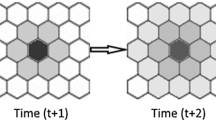Abstract
The plasmodium of Physarum polycephalum is a unicellular giant amoeba that grows up to macroscopic scale under appropriate condition, and is known to its computational abilities. In this study, we tried to observe the long-term exploratory behavior of the plasmodium in an open environment and to evaluate its efficiency. For this purpose, we developed an experimental system with an extendable substrate. As a result of the experiment, we found that the frequency distribution of the speed of plasmodial locomotion is fitted by power function. By simulation, we further tried to estimate the efficiency of the exploration implemented with the patterns from the plasmodium, and confirmed that it is actually effective.










Similar content being viewed by others
References
Nakagaki T, Yamada H, Tóth Á (2000) Maze-solving by an amoeboid organism. Nature 407:479
Shirakawa T, Gunji YP (2007) Emergence of morphological order in the network formation of Physarum polycephalum. Biophys Chem 128:253–260
Aono M, Hara M (2008) Spontaneous Deadlock breaking on amoeba-based neurocomputer. Biosystems 91:83–93
Shirakawa T, Gunji YP, Miyake M (2011) An associative learning experiment using the plasmodium of Physarum polycephalum. Nano Commun Netw 2:99–105
Wolke A, Niemeyer F, Achenbach F (1987) Geotactic behavior of the acellular myxomycete Physarum polycephalum. Cell Biol Int Rep 11:525–528
Anderson JD (1951) Galvanotaxis of slime mold. J Gen Physiol 35:1–16
Shirakawa T, Konagano R, Inoue K (2012) Novel taxis of the Physarum plasmodium and a taxis-based simulation of Physarum swarm. In: Proceeding of the joint 6th international conference on soft computing and intelligent systems and 13th international symposium on advanced intelligent systems, Kobe, Hyogo Japan, Nov 20–24, 2012, pp 296–300
Tero A, Saigusa T, Ito K, Bebber DP, Fricker MD, Yumiki K, Kobayashi R, Nakagaki T (2010) Rules for biologically inspired adaptive network design. J Theor Biol 256:29–44
Viswanathan GM, Bartumeus F, Buldyrev SV, Catalan J, Fulco UL, Havlin S, Luz MGE, Lyra ML, Raposo EP, Stanley HE (2002) Lévy flight random searches in biological phenomena. Phys A 314:208–213
Rasband WS (1997–2012) ImageJ, U. S. National Institutes of Health, Bethesda, Maryland, USA. http://imagej.nih.gov/ij/
Author information
Authors and Affiliations
Corresponding author
About this article
Cite this article
Shirakawa, T., Sato, H. & Nishida, M. A power law in the exploratory behavior of the Physarum plasmodium. Artif Life Robotics 21, 195–200 (2016). https://doi.org/10.1007/s10015-016-0269-6
Received:
Accepted:
Published:
Issue Date:
DOI: https://doi.org/10.1007/s10015-016-0269-6




